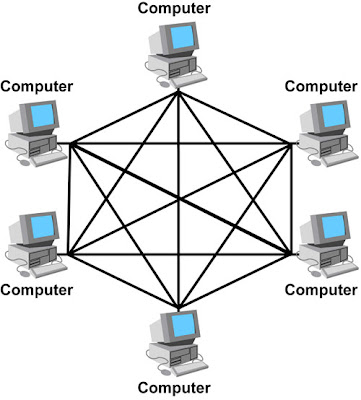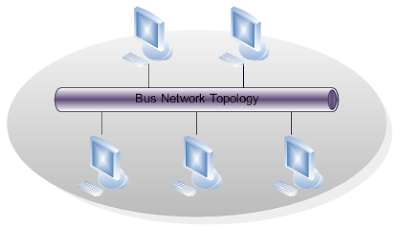Introduction:- Network topology is the architecture of the wires which we use to connect one computer to the other in a network. There are 4 topologies we use to establish a network for the communication. Every topology has its own advantages and disadvantages. The different topologies are:-
1. Mesh topology
2. bus topology
3. star topology
4. ring topology
Mesh topology:- The basic principle of this topology is to
connect every single computer to every other computer to form a network. This
topology is suitable for small no. of computers but if there is large no. of computers
then this topology becomes complex and is rarely used. It becomes tedious and
complex to connect every single computer to every other computers when the no. of
computers is large. This type of topology is used in Supercomputers. There is
no any intermediate in between the wires therefore it increases the speed and
hence is used in the supercomputers.
Advantages:- a) Speed is high because of no intermediates in
the wires. That’s why is used in Supercomputers.
b) The network can be expanded without interrupting the
other users.
Disadvantages:- a) It requires large no of wires. Therefore,
cable cost is too high.
b) It forms the complex circuit.
Bus topology:- There
is a single wire which is having T connectors to connect all the computers with
each other to form a network. The wire is basically a dead
wire but the part of the wire having computers on its both sides shall not be a
dead wire means there will be a current in it. 10 Base-2, 10 Base-5 are the examples of wires used years ago. Any no.
of computers can be connected with this type of topology. Bus topology can be
seen in the computer labs to connect computers.
Advantages:- a) It
requires less no. of cables. So cable cost is not high.
b) It is easy to implement.
Disadvantages:- a) A single break in the wire will stop the
connection of other computers too.
b) The troubleshooting is difficult.
Star topology:- In this type of topology, we use an
intelligent device called Hub or Switch to connect all the computers to form a
network. There is a chip in the Hub that will decide the path of the data flow
in the wires. The single wire will be required to connect one computer to the
Hub. So the no. of computers will required the same no. of wires to connect to
the the Hub.
The Hub is the single point of failure. The failure in one
computer will not interrupt the other computer. So this is the most widely used
topology in the networking of computers. This topology can be seen in the
servers.
Advantages:- a) Point to point connection between the
computers and the Hub.
b) Failure in one computer will not interrupt the working of
other computers.
c) Easy to troubleshoot the problem.
Disadvantages:- a) Again
it requires the same no. of cables equal to the no. of computers. So, for a
large no. of computers, large no. of cables are required.
b) Difficult to implement.
Ring topology:- This topology uses the principle of
connecting every computer with its adjacent computer and not to all other
computers. So the flow of data will form a circular path from one computer to
another computer. This type of topology can be seen in the servers. Ring
topology can be implemented by using SONET,FDDI or Token Ring technology.
Advantages:- a) Easy to install
b) Troubleshooting is easier because cable faults are easily
located.
Disadvantages:- a) A single break or fault in the wire will
halt the entire network.
b) Expansion of the network will disrupt the other users of
the network.
Credits:- Yuvraj Salaria




